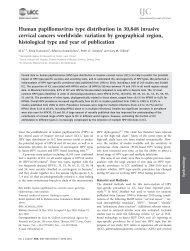You also want an ePaper? Increase the reach of your titles
YUMPU automatically turns print PDFs into web optimized ePapers that Google loves.
3: <strong>HPV</strong> AND CERVICAL CANCER: PUBLIC HEALTH PERSPECTIVESIntroductionAppropriately organized cervical cancer screening based on cervicalcytology (the Pap smear test) markedly reduces both cervical cancerincidence and mortality. 1–3 Finland has one of the lowest rates ofcervical cancer incidence in Europe and has documented decreases ofalmost 75% in its incidence and 90% in mortality rate since theintroduction of a national Pap smear-based cervical cancer screeningprogramme in the early 1970s. 4–10Rationale of cytology-based screening forcervical cancerWithin a public health context, the objective of screening is theidentification of disease while in a preclinical state, so that its furtherdevelopment (and therefore consequent mortality) can be reduced.Screening should be regarded as public health policy, in that it isapplied to populations rather than individual patients, although, inpractice, the distinction between screening and case-finding issometimes difficult to make, because the detection of a preclinicalcancer may occur either within the population-based screeningprogramme or in normal clinical practice.The key elements influencing the success of population-basedscreening (see box) all need to be optimized for a programme tooperate effectively, 1,2,11,12 and deficiency in one or more of thesefactors might explain the suboptimal performance of cervical cancerscreening in some European countries.The performance of the screening test: thePap smearWhen considering the performance of the test, it is important torecognize that a Pap smear result is not unambiguously positive ornegative, and its performance is dependent on the subjective12








